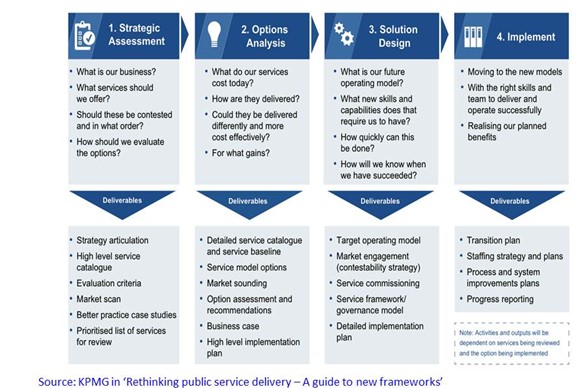TOPIC 5.2: Roles of government – Contested ideas and challenging the status quo
Throughout this unit, we see the role of government and the relationship between government and other sectors coming into question. The contestability process provides an opportunity for government to be innovative in response to the question: is this government business and could someone else be doing this as well or better than government can? Let’s consider the various roles of government. Please think about the role your agency plays in service delivery and whether you think it’s the most appropriate role for the future.
‘Business as usual’ for government has become the business of development, service provision and policy advice. While other terms might be used, these three functions form a buttressing foundation for one description of the government’s role in contemporary society. Government may act as a type of public agent of responsibility to uphold ethical values and principles i.e. an ethical standard setting role.
Government plays a role in setting certain laws and regulations that establish certain standards. For example, the establishment of corporations’ law, environmental standards regulations, health and safety standards and so on are powers wielded exclusively by governments that determine the acceptable and lawful conduct of a community and distinguish the government with a unique role as a standard setter.
Government may exercise control through instruments of regulation. Viewed as a regulator, the state becomes something akin to an umpire who intervenes to reign-in the excesses of market forces or when self-regulation needs a bit of a helping hand. The impetus for viewing government as a regulator in the bureaucracy has included:
- separating operational from regulatory activities (often through structural reform such as commercialisation, corporatisation and privatisation)
- separating purchasers and providers of public services (through contracting out and market testing)
- separating policy-making from operational tasks within government departments through the establishment of executive agencies.
The idea of government being considered as an ‘enabler’ has emerged from a review of left-centred politics and attempts to piece together a new vision for government amidst the demands of globalisation and rapid technological change. The enabling state encourages community participation and inclusivity and welcomes networked structures to encourage community-led solutions to identified public policy problems.
State governments across Australia have developed and issued state strategic plans and development policies that embrace creativity, contestability and digital technologies to promote government’s role as a catalyst for growth, prosperity and innovation. The policies are strategic and overarching and are aimed both at encouraging private sector investment and innovation as well as creative practices within governments themselves.
Finally, in response to national security challenges, privacy, surveillance and monitoring concerns or intrusive policies regarding family decision-making, healthcare and education, government’s role as a protector remains under scrutiny.
The Deloitte website has some interesting reports on contestability.
In 2013, Victoria, New South Wales and Queensland variously committed to commissioning, renewal and contestability approaches that is innovative approaches to procure and contract services from private, public or not-for-profit organisations to better harness the benefits of competition.
Much has been made of investing in building capability for contestability across the public sector. For those interested in accessing further development in this area keep an eye out for ANZSOG workshops and PSC initiatives.
Exercises
Have a look at the following YouTube video and consider how information is changing/being used in your agency.
- Identify the 5 Vs – volume, variety, velocity, veracity and value
- What are the implications for alternative service design and better customer service?
An overview or generic model of the contestability process is presented in Figure 5.1. below.

Figure 5.1: A Framework for Contestability. Source: The Mandarin[1]
Whilst the process is cyclical it is also iterative – you may revisit initial steps in light of information gathered in later steps.
Required Activity
20 mins
Check your jurisdictional policy framework or approach to contestability.
- KPMG. (2014). How contestability is helping to rethink the role of government. The Mandarin. ↵

